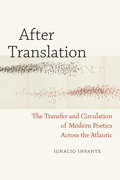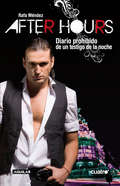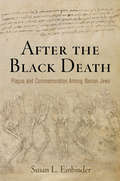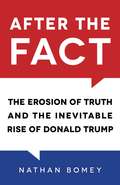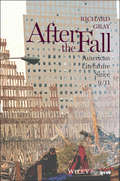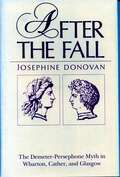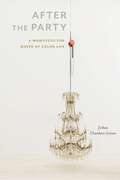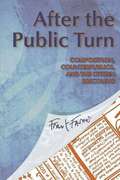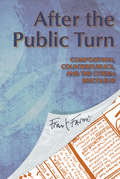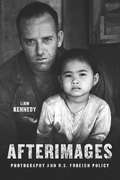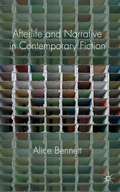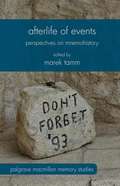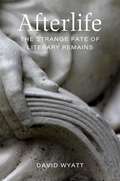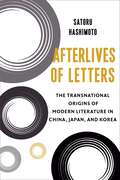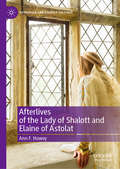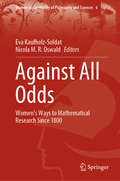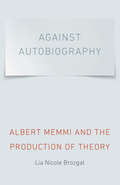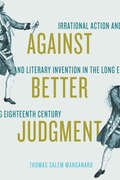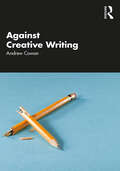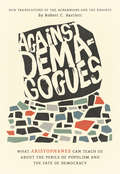- Table View
- List View
After Translation: The Transfer and Circulation of Modern Poetics Across the Atlantic
by Ignacio InfanteTranslation—from both a theoretical and a practical point of view—articulates differing but interconnected modes of circulation in the work of writers originally from different geographical areas of transatlantic encounter, such as Europe, Latin America, North America, and the Caribbean.After Translation examines from a transnational perspective the various ways in which translation facilitates the circulation of modern poetry and poetics across the Atlantic. It rethinks the theoretical paradigm of Anglo-American “modernism” based on the transnational, interlingual, and transhistorical features of the work of key modern poets writing on both sides of the Atlantic— namely, the Portuguese Fernando Pessoa; the Chilean Vicente Huidobro; the Spaniard Federico Garcia Lorca; the San Francisco–based poets Jack Spicer, Robert Duncan, and Robin Blaser; the Barbadian Kamau Brathwaite; and the Brazilian brothers Haroldo and Augusto de Campos.
After hours: Diario prohibido de un testigo de la noche
by Rafa MéndezRafa Méndez, uno de los profesores más hot de Fama ¡A bailar!, nos cuenta en After hours todo lo que experimentó durante las grabaciones del programa, lo que pudo ver, oír, sentir, las personas que conoció; las situaciones más incómodas y las más morbosas. Acompañados por un estilo directo, lleno de energía y gracias a su particular visión del mundo, recorreremos la cara oculta de la noche, la más inhóspita, la más adictiva, la de más sexo, la más real. Todo aquello que queremos conocer pero que no nos atrevemos a mirar de frente: la vida misma. Un testimonio adrenalínico y veraz que recoge experiencias sorprendentes, excitantes, dobles vidas y verdaderas historias de supervivencia. El libro que podrás leer y disfrutar mientras los demás duermen. Rafa Méndez se ha formado como profesional del baile en España, Italia, Londres y Los Ángeles, donde ha perfeccionado un estilo actual y fresco. Ha colaborado con coreógrafos de gran prestigio internacional como los de Madonna, Kylie Minogue, Robbie Williams o Take That, y ha trabajado como primer bailarín, coreógrafo y presentador en la RAI junto a Raffaella Carrá. Ha protagonizado vídeos y tours musicales con grandes artistas de la talla de Geri Halliwell o Tiziano Ferro, y ha sido coreógrafo de la cadena musical MTV Internacional. Forma parte del claustro de profesores del exitoso programa Fama ¡A bailar! y en la actualidad es presentador en Cuatro del programa After hours.
After the American Century: The Ends of U.S. Culture in the Middle East
by Brian EdwardsWhen Henry Luce announced in 1941 that we were living in the "American century," he believed that the international popularity of American culture made the world favorable to U.S. interests. Now, in the digital twenty-first century, the American century has been superseded, as American movies, music, and video games are received, understood, and transformed. <P><P>How do we make sense of this shift? Building on a decade of fieldwork in Cairo, Casablanca, and Tehran, Brian T. Edwards maps new routes of cultural exchange that are innovative, accelerated, and full of diversions. Shaped by the digital revolution, these paths are entwined with the growing fragility of American "soft" power. They indicate an era after the American century, in which popular American products and phenomena—such as comic books, teen romances, social-networking sites, and ways of expressing sexuality—are stripped of their associations with the United States and recast in very different forms. Arguing against those who talk about a world in which American culture is merely replicated or appropriated, Edwards focuses on creative moments of uptake, in which Arabs and Iranians make something unexpected. He argues that these products do more than extend the reach of the original. They reflect a world in which culture endlessly circulates and gathers new meanings.
After the Black Death: Plague and Commemoration Among Iberian Jews (The Middle Ages Series)
by Susan L. EinbinderThe Black Death of 1348-50 devastated Europe. With mortality estimates ranging from thirty to sixty percent of the population, it was arguably the most significant event of the fourteenth century. Nonetheless, its force varied across the continent, and so did the ways people responded to it. Surprisingly, there is little Jewish writing extant that directly addresses the impact of the plague, or even of the violence that sometimes accompanied it. This absence is particularly notable for Provence and the Iberian Peninsula, despite rich sources on Jewish life throughout the century.In After the Black Death, Susan L. Einbinder uncovers Jewish responses to plague and violence in fourteenth-century Provence and Iberia. Einbinder's original research reveals a wide, heterogeneous series of Jewish literary responses to the plague, including Sephardic liturgical poetry; a medical tractate written by the Jewish physician Abraham Caslari; epitaphs inscribed on the tombstones of twenty-eight Jewish plague victims once buried in Toledo; and a heretofore unstudied liturgical lament written by Moses Nathan, a survivor of an anti-Jewish massacre that occurred in Tàrrega, Catalonia, in 1348.Through elegant translations and masterful readings, After the Black Death exposes the great diversity in Jewish experiences of the plague, shaped as they were by convention, geography, epidemiology, and politics. Most critically, Einbinder traces the continuity of faith, language, and meaning through the years of the plague and its aftermath. Both before and after the Black Death, Jewish texts that deal with tragedy privilege the communal over the personal and affirm resilience over victimhood. Combined with archival and archaeological testimony, these texts ask us to think deeply about the men and women, sometimes perpetrators as well as victims, who confronted the Black Death. As devastating as the Black Death was, it did not shatter the modes of expression and explanation of those who survived it—a discovery that challenges the applicability of modern trauma theory to the medieval context.
After the Fact: The Erosion of Truth and the Inevitable Rise of Donald Trump
by Nathan BomeyThis trenchant analysis examines the many ways our society's increasingly tenuous commitment to facts laid the groundwork for Donald Trump's rise to power.Award-winning journalist Nathan Bomey argues that Trump did not usher the post-truth era into being. He was its inevitable outcome. Bomey points to recent trends that have created the perfect seedbed for spin, distortion, deception, and bald-faced lies: shifting news habits, the rise of social media, the spread of entrenched ideologies, and the failure of schools to teach basic critical-thinking skillsThe evidence supporting the author's argument is all around us: On Facebook, we present images of our lives that ignore the truth and intentionally deceive our friends and family. We consume fake news stories online and carelessly circulate false rumors. In politics, we vote for leaders who leverage political narratives that favor ideology over science. And in our schools, we fail to teach students how to authenticate information.After the Fact explores how the convergence of technology, politics, and media has ushered in the misinformation age, sidelining the truth and threatening our core principle of community.
After the Fall
by Richard GrayAfter the Fall presents a timely and provocative examination of the impact and implications of 9/11 and the war on terror on American culture and literature. Presents the first detailed interrogation of U.S. writing in a time of crisis Develops a timely and provocative arguement about literature and trauma Relates U.S. writing since 9/11 to crucial social and historical changes in the U.S. and elsewhere Places U.S. writing in the context of the transformed position of the U.S. in a world characterized by political, economic, and military crisis; transnational drift; the resurgence of religious fundamentalism; and the apparent triumph of global capitalism
After the Fall: The Demeter-Persephone Myth in Wharton, Cather, and Glasgow (G - Reference, Information and Interdisciplinary Subjects)
by Josephine DonovanA continuation of Josephine Donovan's exploration of American women's literary traditions, begun with New England Local Color Literature: A Women's Tradition, which treats the nineteenth-century realists, this work analyzes the writing of major women writers of the early twentieth century—Edith Wharton, Willa Cather, and Ellen Glasgow.The author sees the Demeter-Persephone myth as central to these writers' thematics, but interprets the myth in terms of the historical transitions taking place in turn-of-the-century America. Donovan focuses on the changing relationship between mothers and daughters—in particular upon the "new women's" rebellion against the traditional women's culture of their nineteenth-century mothers (both literary and literal). An introductory chapter traces the male-supremacist ideologies that formed the intellectual climate in which these women wrote.Reorienting Wharton, Cather, and Glasgow within women's literary traditions produces major reinterpretations of their works, including such masterpieces as Ethan Frome, Summer, My Antonia, Barren Ground, and others.
After the Human: Culture, Theory and Criticism in the 21st Century (After Series #6)
by Sherryl VintAfter the Human provides a comprehensive overview of how a range of philosophical, ethical, and political ideas under the framework of posthumanism have transformed humanities scholarship today. Bringing together a range of interdisciplinary scholars and perspectives, it puts into dialogue the major influences from philosophy, literary study, anthropology, and science studies that set the stage for a range of new questions to be asked about the relationship of the human to other life. The book's central argument is that posthumanism's challenge to and disruption of traditional humanist knowledge is so significant as to presage a sea-change from the humanities into the posthumanities. After the Human documents the emergence of posthumanist ideas in the fractures within traditional disciplines, examines the new objects of analysis that thus came into prominence, and theorizes new interdisciplinary methods of study that followed.
After the Last Sky: Palestinian Lives
by Edward W. Said Jean MohrA searing portrait of Palestinian life and identity that is at once an exploration of Edward Said's unclaimable past and a testimony to the lives of those living in exile.
After the Party: A Manifesto for Queer of Color Life (Sexual Cultures #4)
by Joshua Chambers-LetsonWinner, 2019 ATHE Outstanding Book Award, given by the Association for Theatre in Higher EducationWinner, 2018 Errol Hill Award in African American theater, drama, and/or performance studies, presented by the American Society for Theatre ResearchA new manifesto for performance studies on the art of queer of color worldmaking. After the Party tells the stories of minoritarian artists who mobilize performance to produce freedom and sustain life in the face of subordination, exploitation, and annihilation. Through the exemplary work of Nina Simone, Jorge Ignacio Cortiñas, Danh Vō, Felix Gonzalez-Torres, Eiko, and Tseng Kwong Chi, and with additional appearances by Nao Bustamante, Audre Lorde, Martin Wong, Assata Shakur, and Nona Faustine, After the Party considers performance as it is produced within and against overlapping histories of US colonialism, white supremacy, and heteropatriarchy. Building upon the thought of José Esteban Muñoz alongside prominent scholarship in queer of color critique, black studies, and Marxist aesthetic criticism, Joshua Chambers-Letson maps a portrait of performance’s capacity to produce what he calls a communism of incommensurability, a practice of being together in difference. Describing performance as a rehearsal for new ways of living together, After the Party moves between slavery, the Civil Rights Movement, the first wave of the AIDS crisis, the Vietnam War, and the catastrophe-riddled horizon of the early twenty-first century to consider this worldmaking practice as it is born of the tension between freedom and its negation. With urgency and pathos, Chambers-Letson argues that it is through minoritarian performance that we keep our dead alive and with us as we struggle to survive an increasingly precarious present.
After the Public Turn
by Frank FarmerIn After the Public Turn, author Frank Farmer argues that counterpublics and the people who make counterpublics--"citizen bricoleurs"--deserve a more prominent role in our scholarship and in our classrooms. Encouraging students to understand and consider resistant or oppositional discourse is a viable route toward mature participation as citizens in a democracy. Farmer examines two very different kinds of publics, cultural and disciplinary, and discusses two counterpublics within those broad categories: zine discourses and certain academic discourses. By juxtaposing these two significantly different kinds of publics, Farmer suggests that each discursive world can be seen, in its own distinct way, as a counterpublic, an oppositional social formation that has a stake in widening or altering public life as we know it.Drawing on major figures in rhetoric and cultural theory, Farmer builds his argument about composition teaching and its relation to the public sphere, leading to a more sophisticated understanding of public life and a deeper sense of what democratic citizenship means for our time.
After the Public Turn: Composition, Counterpublics, and the Citizen Bricoleur (G - Reference, Information And Interdisciplinary Subjects Ser.)
by Frank FarmerIn After the Public Turn, author Frank Farmer argues that counterpublics and the people who make counterpublics—“citizen bricoleurs”—deserve a more prominent role in our scholarship and in our classrooms. Encouraging students to understand and consider resistant or oppositional discourse is a viable route toward mature participation as citizens in a democracy. Farmer examines two very different kinds of publics, cultural and disciplinary, and discusses two counterpublics within those broad categories: zine discourses and certain academic discourses. By juxtaposing these two significantly different kinds of publics, Farmer suggests that each discursive world can be seen, in its own distinct way, as a counterpublic, an oppositional social formation that has a stake in widening or altering public life as we know it. Drawing on major figures in rhetoric and cultural theory, Farmer builds his argument about composition teaching and its relation to the public sphere, leading to a more sophisticated understanding of public life and a deeper sense of what democratic citizenship means for our time.
After the Tall Timber (W&N Essentials)
by Renata AdlerIn these 21 essays of nonfiction Adler draws on Toward a Radical Middle (a selection of her earliest New Yorker pieces), A Year in the Dark (her film reviews), and Canaries in the Mineshaft (a selection of essays on politics and media), and also includes uncollected work from the past two decades. Adler is first and foremost a journalist, and positions herself as a centrist. The pieces are concerned with, in her words, misrepresentation, coercion, and abuse of public process, and, to a degree, the journalist's role in it. With a brilliant literary and legal mind, Adler parses power by analyzing language: the language of courts, of journalists, of political figures, of the man on the street. In doing so, she unravels the tangled narratives that pass for the resolution of scandal and finds the threads that others miss. Adler delves into the ones that explain what really is going on here from the Watergate scandal, to the preposterous Kenneth Starr report submitted to the House during the Clinton impeachment inquiry, to the plagiarism and fabrication scandal of the former New York Times reporter Jayson Blair. And she writes extensively about the Supreme Court and the power of its rulings, including its fateful decision in Bush v. Gore.
Afterimages
by Liam KennedyIn 2005, photographer Chris Hondros captured a striking image of a young Iraqi girl in the aftermath of the killing of her parents by American soldiers. The shot stunned the world and has since become iconic--comparable to the infamous photo by Nick Ut of a Vietnamese girl running from a napalm attack. Both images serve as microcosms for their respective conflicts. Afterimages looks at the work of war photographers like Hondros and Ut to understand how photojournalism interacts with the American worldview. Liam Kennedy here maps the evolving relations between the American way of war and photographic coverage of it. Organized in its first section around key US military actions over the last fifty years, the book then moves on to examine how photographers engaged with these conflicts on wider ethical and political grounds, and finally on to the genre of photojournalism itself. Illustrated throughout with examples of the photographs being considered, Afterimages argues that photographs are important means for critical reflection on war, violence, and human rights. It goes on to analyze the high ethical, sociopolitical, and legalistic value we place on the still image's ability to bear witness and stimulate action.
Afterlife and Narrative in Contemporary Fiction
by Alice BennettAfterlife and Narrative explores why life after death is such a potent cultural concept today, and why it is such an attractive prospect for modern fiction. The book mines a rich vein of imagined afterlives, from the temporal experiments of Martin Amis's Time's Arrow to narration from heaven in Alice Sebold's The Lovely Bones. At the heart of the book is a focus on how the properties of the afterlife have become a tool for examining the capacities and conventions of narrative fiction. Modern novels carry the history of realism and its attempts to present life as it is, but many of the techniques which achieve these effects require perspectives and positions for narration that are profoundly un-lifelike. Each chapter of the book takes a fresh look at problems in narrative theory, taking all its cues from experimental narratives set in the afterlife, from avant-garde experimentation to popular genre fiction. Afterlife and Narrative examines, applies and refines anti-mimetic theories of fiction in readings of a group of texts which are after, but not in imitation of, life.
Afterlife of Events
by Marek TammRecently, we have witnessed a rearticulation of the traditional relationship between the past, present and future, broadening historiography's range from studying past events to their later impact and meaning. The volume proposes to look at the perspectives of this approach called mnemohistory, and argues for a redefinition of the term 'event'.
Afterlife: The Strange Fate of Literary Remains
by David WyattAfterlife: The Strange Fate of Literary Remains explores what happens to a body of work left unpublished or unfinished at the time of a writer’s death. In nine chapters, David Wyatt tells the story of the “afterlife” of texts by Shakespeare, William Wordsworth, Charles Dickens, Harriet Jacobs, Emily Dickinson, William Faulkner, Sylvia Plath, Ernest Hemingway, and Ralph Ellison—and of the improbable and unpredictable ways in which literature that might never have seen publication managed to end up on the printed page. Posthumously edited texts raise important issues about the meaning and shape of a literary career. How is one to assess the arc of Ellison’s achievement when, after his endlessly reworked second novel finally made it into print in 1999, it was then superseded, in 2010, by another version? Meanwhile, the publication of four Hemingway books after the author’s death undid any notion that the writer suffered some sort of decline late in life, and the gender-bending experiments in The Garden of Eden cast a revisionary light back on what had become a deeply reductive belief in the Hemingway Code. While judgments about these writings may begin as technical matters, Wyatt shows that they eventually become aesthetic and, finally, ethical considerations. Despite the difficulties involved, such evaluations continue to be made and to produce the editions that teachers and readers are required to choose among. Throughout Afterlife, Wyatt stresses the attentiveness needed in the editing of posthumous texts: being mindful to honor an author’s literary remains by providing an answerable reading of them, while also caring enough about the work left behind to take a position on the printed form it might best take or, if such a conclusion feels impossible, to give a responsible account of why it is out of reach.
Afterlives of Endor: Witchcraft, Theatricality, and Uncertainty from the "Malleus Maleficarum" to Shakespeare
by Laura LevineAfterlives of Endor offers an analysis of the way early modern English literature addressed the period's anxieties about witchcraft and theatricality. What determined whether or not a demonologist imagined a trial as a spectacle? What underlying epistemological constraints governed such choices and what conceptions of witchcraft did these choices reveal? Pairing readings of demonological texts with canonical plays and poetry, Laura Levine examines such questions. Through analyses of manuals and pamphlets about the prosecution of witches—including Reginald Scot's skeptical The Discoverie of Witchcraft (1584), King James VI/I's Daemonologie (1597), and Jean Bodin's De la Demonomanie des Sorciers (1580)—Afterlives of Endor examines the way literary texts such as Shakespeare's The Winter's Tale and The Tempest, Spenser's The Faerie Queene, and Marlowe's Tragicall History of Doctor Faustus address anxieties about witchcraft, illusion, and theatricality. Afterlives of Endor attends to the rhetorical tactics, argumentative investments, and underlying tensions of demonological texts with the scrutiny ordinarily reserved for literary texts.
Afterlives of Letters: The Transnational Origins of Modern Literature in China, Japan, and Korea (Studies of the Weatherhead East Asian Institute, Columbia University)
by Satoru HashimotoWhen East Asia opened itself to the world in the nineteenth century, Chinese, Japanese, and Korean intellectuals had shared notions of literature because of the centuries-long cultural exchanges in the region. As modernization profoundly destabilized cultural norms, they ventured to create new literature for the new era.Satoru Hashimoto offers a novel way of understanding the origins of modern literature in a transregional context, drawing on Chinese-, Japanese-, and Korean-language texts in both classical and vernacular forms. He argues that modern literature came into being in East Asia through writerly attempts at reconstructing the present’s historical relationship to the past across the cultural transformations caused by modernization. Hashimoto examines writers’ anachronistic engagement with past cultures deemed obsolete or antithetical to new systems of values, showing that this transnational process was integral to the emergence of modern literature.A groundbreaking cross-cultural excavation of the origins of modern literature in East Asia featuring remarkable linguistic scope, Afterlives of Letters bridges Asian studies and comparative literature and delivers a remapping of world literature.
Afterlives of the Lady of Shalott and Elaine of Astolat (Arthurian and Courtly Cultures)
by Ann F. HoweyThis book investigates adaptations of The Lady of Shalott and Elaine of Astolat in Victorian and post-Victorian popular culture to explore their engagement with medievalism, social constructions of gender, and representations of the role of art in society. Although the figure of Elaine first appeared in medieval texts, including Malory’s Le Morte Darthur, Tennyson’s poems about the Lady and Elaine drew unprecedented response from musicians, artists, and other authors, whose adaptations in some cases inspired further adaptations. With chapters on music, art, and literature (including parody, young people’s literature, and historical fiction and fantasy), this book seeks to trace the evolution of these characters and the ways in which they reinforce or challenge conventional gender roles, represent the present’s relationship to the past, and highlight the power of art.
Against All Odds: Women’s Ways to Mathematical Research Since 1800 (Women in the History of Philosophy and Sciences #6)
by Eva Kaufholz-Soldat Nicola M. R. OswaldThis book presents an overview of the ways in which women have been able to conduct mathematical research since the 18th century, despite their general exclusion from the sciences. Grouped into four thematic sections, the authors concentrate on well-known figures like Sophie Germain and Grace Chisholm Young, as well as those who have remained unnoticed by historians so far. Among them are Stanisława Nidodym, the first female students at the universities in Prague at the turn of the 20th century, and the first female professors of mathematics in Denmark. Highlighting individual biographies, couples in science, the situation at specific European universities, and sociological factors influencing specific careers from the 18th century to the present, the authors trace female mathematicians’ status as it evolved from singular and anomalous to virtually commonplace.The book also offers insights into the various obstacles women faced when trying to enter perhaps the “most male” discipline of all, and how some of them continue to shape young girls’ self-perceptions and career choices today. Thus, it will benefit scholars and students in STEM disciplines, gender studies and the history of science; women in science, mathematics and at institutions, and those working in mathematics education.
Against Autobiography: Albert Memmi and the Production of Theory
by Lia Nicole BrozgalThe work of Tunisian Jewish intellectual Albert Memmi, like that of many francophone Maghrebian writers, is often read as thinly veiled autobiography. Questioning the prevailing body of criticism, which continues this interpretation of most fiction produced by francophone North African writers, Lia Nicole Brozgal shows how such interpretations of Memmi’s texts obscure their not inconsiderable theoretical possibilities.Calling attention to the ambiguous status of autobiographical discursive and textual elements in Memmi’s work, Brozgal shifts the focus from the author to theoretical questions. Against Autobiography places Memmi’s writing and thought in dialogue with several major critical shifts in the late twentieth-century literary and cultural landscape. These shifts include the crisis of the authorial subject; the interrogation of the form of the novel; the resistance to the hegemony of vision; and the critique of colonialism. Showing how Memmi’s novels and essays produce theories that resonate both within and beyond their original contexts, Brozgal argues for allowing works of francophone Maghrebi literature to be read as complex literary objects, that is, not simply as ethnographic curios but as generating elements of literary theory on their own terms.
Against Better Judgment: Irrational Action and Literary Invention in the Long Eighteenth Century
by Thomas Salem ManganaroRobinson Crusoe recognizes it is foolish to leave for the open seas; nevertheless, he boards the ship. William Wordsworth of The Prelude sees the immense poetic task ahead of him, but instead of beginning work, he procrastinates by going for a walk. Centering on this sort of intentionally irrational action, originally defined as " akrasia" by the ancient Greeks and "weakness of will" in early Christian thought, Against Better Judgment argues that the phenomenon takes on renewed importance in the long eighteenth century.In treating human minds and bodies as systems and machines, Enlightenment philosophers did not account for actions that may be undermotivated, contradictory, or self-betraying. A number of authors, from Daniel Defoe and Samuel Johnson to Jane Austen and John Keats, however, took up the phenomenon in inventive ways. Thomas Manganaro traces how English novelists, essayists, and poets of the period sought to represent akrasia in ways philosophy cannot, leading them to develop techniques and ideas distinctive to literary writing, including new uses of irony, interpretation, and contradiction. In attempting to give shape to the ways people knowingly and freely fail themselves, these authors produced a new linguistic toolkit that distinguishes literature’s epistemological advantages when it comes to writing about people.
Against Creative Writing
by Andrew CowanThe rise of Creative Writing has been accompanied from the start by two questions: can it be taught, and should it be taught? This scepticism is sometimes shared even by those who teach it, who often find themselves split between two contradictory identities: the artistic and the academic. Against Creative Writing explores the difference between ‘writing’, which is what writers do, and Creative Writing, which is the instrumentalisation of what writers do. Beginning with the question of whether writing can or ought to be taught, it looks in turn at the justifications for BA, MA, and PhD courses, and concludes with the divided role of the writer who teaches. It argues in favour of Creative Writing as a form of hands-on literary education at undergraduate level and a form of literary apprenticeship at graduate level, especially in widening access to new voices. It argues against those forms of Creative Writing that lose sight of literary values – as seen in the proliferation of curricular couplings with non-literary subjects, or the increasing emphasis on developing skills for future employment. Against Creative Writing, written by a writer, is addressed to other writers, inside or outside the academy, at undergraduate or graduate level, whether ‘creative’ or ‘critical’.
Against Demagogues: What Aristophanes Can Teach Us about the Perils of Populism and the Fate of Democracy, New Translations of the Acharnians and the Knights
by Prof. Robert C. BartlettTimeless comedies on resisting tyranny from one of history’s greatest comic playwrights. Against Demagogues presents Robert C. Bartlett's new translations of Aristophanes' most overtly political works, the Acharnians and the Knights. In these fantastically inventive, raucous, and raunchy comedies, the powerful politician Cleon proves to be democracy's greatest opponent. With unrivalled power, both plays make clear the dangers to which democracies are prone, especially the threats posed by external warfare, internal division, and class polarization. Combating the seductive allure of demagogues and the damage they cause, Against Demagogues disentangles Aristophanes' serious teachings from his many jokes and pratfalls, substantiating for modern readers his famous claim to "teach justice" while "making a comedy" of the city. The book features an interpretive essay for each play, expertly guiding readers through the most important plot points, explaining the significance of various characters, and shedding light on the meaning of the plays' often madcap episodes. Along with a contextualizing introduction, Bartlett offers extensive notes explaining the many political, literary, and religious references and allusions. Aristophanes' comedic skewering of the demagogue and his ruthless ambition—and of a community so ill-informed about the doings of its own government, so ready to believe in empty promises and idle flattery—cannot but resonate strongly with readers today around the world.
